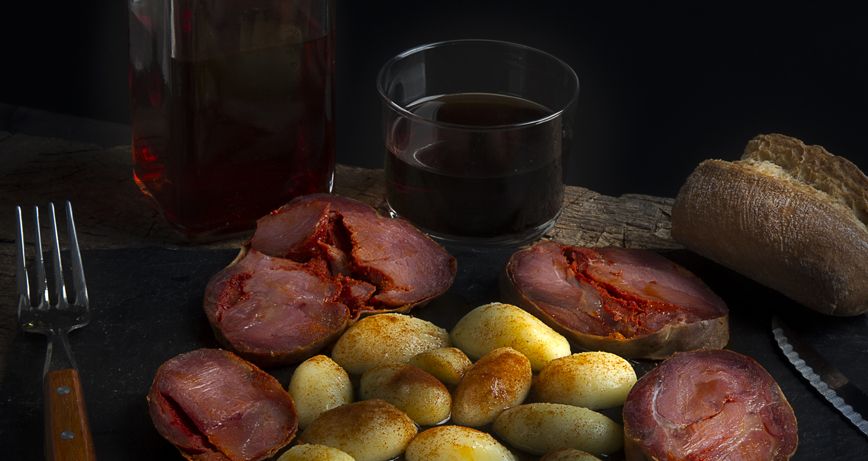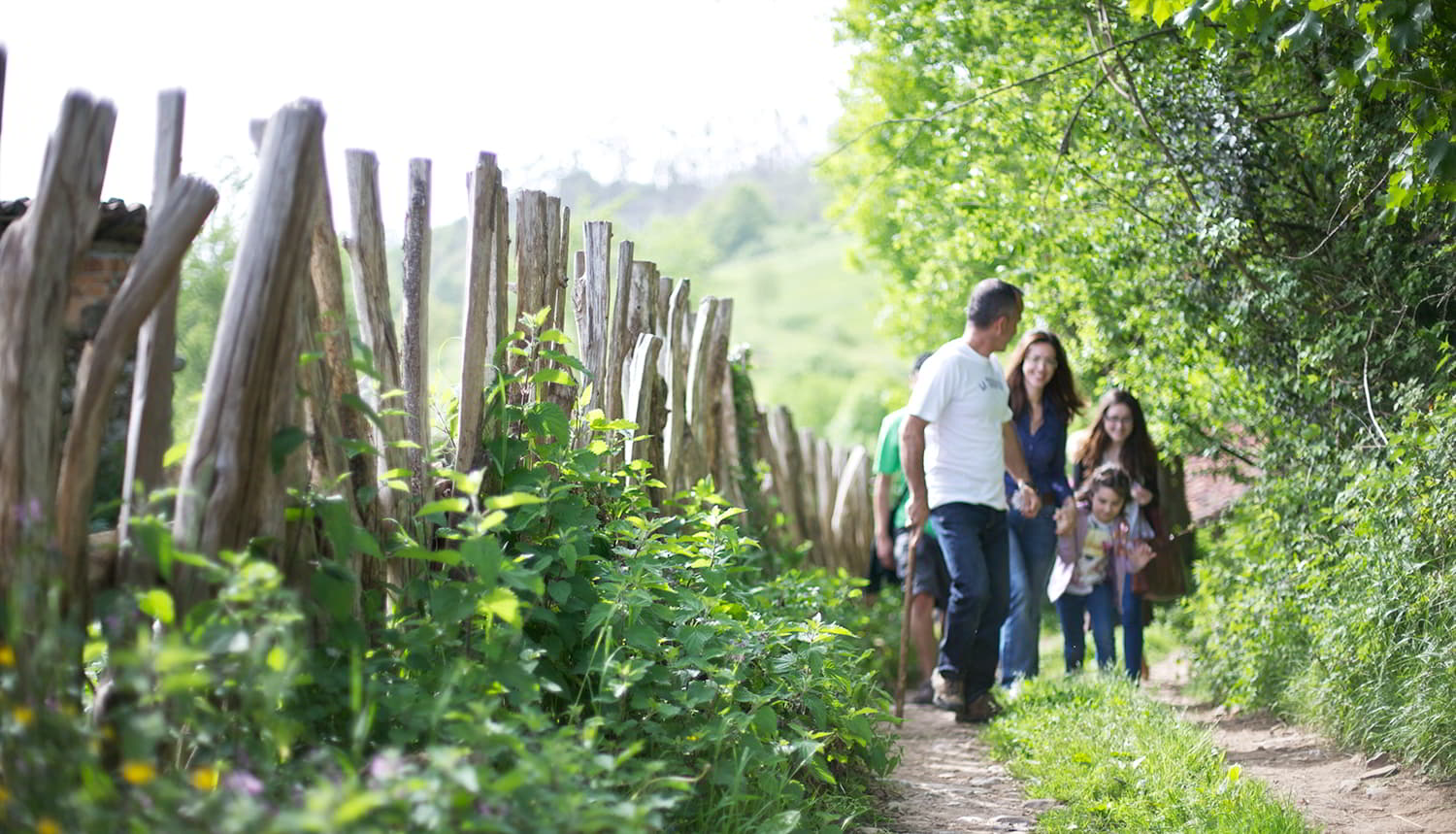Back What to eat in Asturias? 10 typical Asturian dishes

The 10 most interesting typical dishes of Asturias
If any selection implies an injustice, these ten typical dishes of Asturian gastronomy that we present to you make up a list of unmissable dishes that do not detract from those that are absent: chorizos in cider, escalopines al Cabrales, bollo preñao, fillets of local veal or goat's pie. Fortunately, the typical food brings together dozens of recipes, dishes and culinary flags. Here are some of the ones you should not miss under any circumstances.
Asturian Fabada
Asturias' most emblematic dish, fabada, is a traditional stew that combines fabes (beans) with sausages such as chorizo and black pudding, creating a tasty and comforting mixture.

"The story of fabada is the story of the country's prosperity; the story of the recent times of fat cows and fat pigs. It is not that there were no beans, black pudding, bacon, chorizo and ham; it is that no one was so lavish as to eat it all at once". This is how Paco Ignacio Taibo I presents his "Breviario de la Fabada", the most complete praise of the dish by which Asturian food is identified outside its borders. Although his recipe is canonical, with ingredients that are included in the aforementioned quotation (with the ham being, specifically, lacón), each restaurant and house has its own tricks and habits to make it special. And it always triumphs. Because Asturian fabada "is perhaps the most expensive thing in the world, except for the shows at the Lido in Paris". A tip: it is delicious with cava, champagne or a lambic beer. Or cider, of course.
Asturian stew
Similar to chestnut stew, Asturian pot is an Asturian stew that combines different ingredients from the region, such as pulses, potatoes and meat, slowly cooked to achieve a delicious mixture.

Where do you think fabada comes from, if not from 'pote', probably the oldest of the typical Asturian dishes? The name 'pote' comes from the pot in which it was cooked, an earthenware pot which in the 18th century became an iron pot, as Eduardo Méndez Riestra refers to in his 'Diccionario de cocina y gastronomía de Asturias' (Dictionary of Asturian cuisine and gastronomy). Originally it was a pot of cabbage, the rude winter vegetable, as there was little else in humble homes to add to it along with some potatoes. As society prospered and the middle classes appeared, the stew, the spoon recipe par excellence, became more and more refined, also receiving its accompaniment of black pudding, chorizo, bacon and other meats, but without losing the essence of its vegetable garden. Today it is a delicacy that envies nothing to the fabada, its bourgeois cousin, and maintains an incomparable rustic air.
Stuffed onions
Stuffed onions, with a blend of local ingredients, create a unique gastronomic experience that highlights Asturian culinary creativity.

Typical of the mining areas, whose gastronomy was enriched at the same time as the development of the wells, receiving recipes brought by the emigrant workers, but also by the foreign engineers and managers who came to the new extractive industry. It is said that this mixed gastronomy gave rise to stuffed onions, with tuna or meat, stewed with their sauce, sometimes finished off in the oven, and which have become the hallmark of a different kind of Asturian food, intimately linked to coal and the society it generated. A dish that is lighter than it looks, that comforts the mood and proves that, with very little, with simple ingredients, you can create a dish full of history.
Pitu de caleya
Referring to the free-range chicken, the Pitu Caleya is appreciated for its tasty meat and is used in various culinary preparations in the region.

A good pitu de caleya is distinguished, when raw, by three characteristics: its flesh is firm and pink, more similar to game. Its bones are hard to break. And its yellow, the yellow of a natural diet, of what the animal has pecked at in the wild, on the caleya (or country road). A totally different yellow from the bright yellow of the supposedly supermarket corn chickens. Pitu is a typical dish because the animal is typical, different from other native birds. It requires a very long cooking time, which results in a brown sauce, delicate meat and the desire to accompany each forkful with a good Cangas wine. You can order it on its own, in rice or you can find it with fabes (beans). And if you have some left over, don't be afraid to ask for a lunch box. It will give you double the enjoyment at home.
Bonito roll
The bonito roll is a dish that features Cantabrian tuna, rolled and prepared in a way that enhances its unique flavour and texture.

How many ways can bonito tuna be cooked? Perhaps the most praised fish of the Asturian sea, along with the pixín (or monkfish), the recipe for bonito roll is a home recipe, from mothers and grandmothers who for decades gave this preparation to their families, in which any part of the animal can be used, but which above all takes advantage of minor cuts and leftovers. Every cook has her own trick. The sauce in which it is cooked usually combines garlic, onion and tomato, sometimes also pepper. Some people spice it up even more with diced cured ham, with a splash of cider or white wine, with spices. If you are used to grilled tuna, or perhaps the aristocratic and delicate ventresca (tuna belly), you will find another dimension in this stew, simpler but wider. Because a roll is also much more filling than it looks.
Tortos
Tortos are a type of corn cakes that accompany many Asturian dishes, providing a crunchy texture and a distinctive flavour.

Corn flour and water. Or maybe a little wheat flour too, because the mixture offers a different texture when frying. Tortos are a poor man's bread if ever there was one, but fortunately they have been recovered over the last few decades in the hotel and catering trade as a base for a thousand and one combinations, from picadillo, to avocado with anchovies or Afuega'l Pitu cheese. One way of choosing where to eat in Asturias could be, perfectly, a list of places where tortos are prepared with wisdom, fresh, with just the right amount of oil. The sweetness of the corn with the salt makes this little circle of happiness the perfect sustenance to top it with whatever you fancy. Mexican tacos? Gyozas? Minipizzas? Try the tortos, then tell me the difference.
Sea Urchin
Sea urchins or sea urchins, prepared in various ways, such as grilled or in soups, to highlight their delicate marine flavour.

"The sea urchin is an extract from the sea, a breath of squalls, an essence of storms", Julio Camba poetically said. This iodine-scented echinoderm was long despised as food for farm animals. Ugly as few others, it contains in its spiky sphere a juice of the sea, in fact. Cooked for just a few minutes, extracting its orange roe and tasting it as it is makes you close your eyes in pleasure, as happens with other shellfish battered by the furious currents of the Bay of Biscay. There is a special tradition in Gijón/Xixón, where they are devoured by the dozen, but they can also be found in humble and fancy restaurants, with original preparations, as well as turned into fish sauces.
Light bulbs
A typical seafood of the region, the limpets are enjoyed in seafood dishes and add an authentic touch to Asturian cuisine.

The most traditional way of preparing them is afogaes, i.e. cooked for a few seconds in their own steam. Although the soup of limpets is also old, and more recently, pasta or rice with these animals with only one shell, like a half-shelled cockle. The best ones are those made from stone, as they do not contain sand. The broth released by these molluscs is an ambrosia, although they require an unbreakable commandment: they must be cooked for a very short time so that they do not become chewy. If they are perfect, you will have to ask for an extra empty plate to pile up the shells.
Frixuelos
Frixuelos are a kind of Asturian crepes, thin and sweet, served as a dessert or snack, often accompanied by sugar or honey.

The normal frixuelo is a sheet that requires a special skill to toast it in the frying pan with a little butter and leave it at its exact cooking point. Then it's up to the imagination with the filling. There is a second version of frixuelos, the vaqueiros, typical of the mountains, larger in size and puffier, but equally delicious. Of course, don't even think of comparing them to French crepes, or you'll find yourself in a loud argument about identity. The frixuelo, in Asturias, is a religion, as it always reminds you of your own family.
Rice pudding
A classic dessert featuring Asturian milk, slow-cooked with rice and sugar, and often sprinkled with cinnamon.

There is no better ending to a typical meal, to this list of unmissable Asturian food. Fans are divided between those who prefer the rice pudding with or without the burnt milk (with a blowtorch and sugar). Logically, the quality depends mainly on the milk, which is superior in these pastures. The classic recipe adds cinnamon and lemon peel, although the secret lies in the chef's patience, stirring constantly so that the starch in the rice gives the rice its distinctive texture. You will notice it in the first spoonful, which will speed up the others if it is perfect.
This Decalogue, we insist, is only a guideline, as it can be completed with many others. In all of them, however, you will find the same spirit, the same intimate amalgamation of egg and breadcrumbs in a cachopo, or tripe and jelly: a traditional cuisine that continues to pay homage to the product, to the ingredient, as its raison d'être for providing pleasure to the diner.

Subscribe to our newsletter and take advantage of offers, discounts, and news
Subscribe



